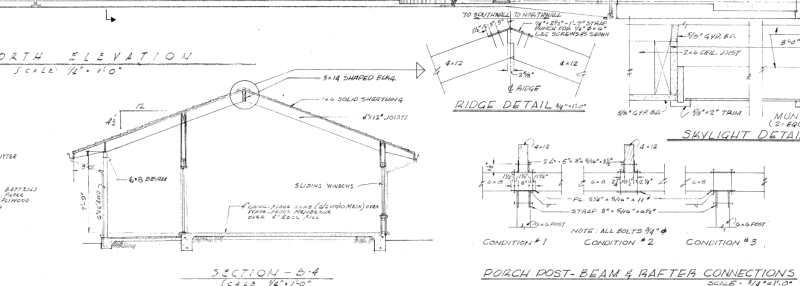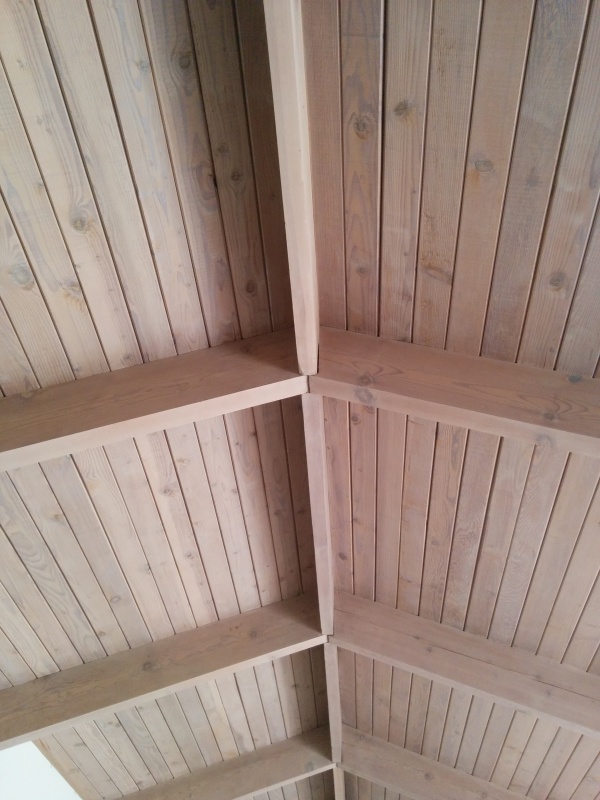jdgengineer
Structural
I'm working on a project that I was hoping to get a second opinion on. The project consists of remodel / addition to an existing home that was built in the 1950s. In the center of the house there is an existing vaulted Living Room. At the peak of this vault there is no ridge beam. Instead, one side of the vaulted rafters cantilever between an existing porch beam and the exterior wall to support the other rafter that is clear spanning between the exterior wall and the ridge. The rafters are tied down to the porch beam, the porch beam to the posts, and the posts are anchored ~2'-0" into the foundation. The backspan-to-cantilever is approximately 1.25:1. At the ridge the rafters are half lapped together with a metal strap applied across the top of them. The rafters are exposed 4x12s at approximately 6'-0" oc. (See attached photo for existing drawings)
As part of the project, the architect is planning on removing the porch beam and replacing it with a new wall (building addition under roof at porch) as well as revising some of the openings in the existing exterior wall at the cantilevered rafter. Since we are tinkering with this existing condition, it's my opinion we are "buying it" and therefore need to make sure that it meets code and is a safe condition. Even if we don't touch the area at all, I am a little concerned with it and my liability.
My main concerns are:
1) The cantilevered rafter is approximately 2x overstressed assuming DF #1. This is likely "old growth" wood and stained / exposed, but there are some knots in the members at the top & bottom which makes me want to use a lower grade.
2) There is an expected uplift force of 1500# at the porch beams. We would be cleaning up this condition with new footings, tiedowns, etc., but I don't like the idea of such a large constant tension in a gravity condition, as small slip in bolts/screws lead to large deflections.
3) The connection at the ridge concerns me with the half lap. The notch is 50% of each member and therefore exceeds the 25% notch allowed per NDS. It appears from my site visit that the rafters have rotated a bit at the ridge as the gap is larger at the bottom (appeared to be about 1/4" to me, but I did not directly measure). To me this rotation then concentrates a large force at the end of one notch, raising my concern with splitting even more. The strap at the top of the rafters seems to only help tie them together at the lap and to provide some uplift resistance.
4) The rafters appear to have split slightly (almost looks like checking) but appears to be in line with one of the notches (see photo)
The condition has stood for the last 60+ years so I know the architect is resistant to modifying it as arguably the revisions we are making do not impact the ridge connection or the design of the rafters. Regardless, I still don't like it and feel it's my responsibility to clean it up.
If the cantilevered rafters were not overstressed, I was considering adding side plates at the ridge connection to reduce forces on the notch as well as making sure the uplift was properly addressed at the backspan. However, with them overstressed I would like to either add a new ridge beam, add rafter ties (threaded rod or joists), or possibly convert the rafters to flitch beams with plates (probably cost prohibitive and not arch desirable).
Looking for a second opinion. What do you all think is the responsible thing in this situation? Any other unique ideas for a fix?


As part of the project, the architect is planning on removing the porch beam and replacing it with a new wall (building addition under roof at porch) as well as revising some of the openings in the existing exterior wall at the cantilevered rafter. Since we are tinkering with this existing condition, it's my opinion we are "buying it" and therefore need to make sure that it meets code and is a safe condition. Even if we don't touch the area at all, I am a little concerned with it and my liability.
My main concerns are:
1) The cantilevered rafter is approximately 2x overstressed assuming DF #1. This is likely "old growth" wood and stained / exposed, but there are some knots in the members at the top & bottom which makes me want to use a lower grade.
2) There is an expected uplift force of 1500# at the porch beams. We would be cleaning up this condition with new footings, tiedowns, etc., but I don't like the idea of such a large constant tension in a gravity condition, as small slip in bolts/screws lead to large deflections.
3) The connection at the ridge concerns me with the half lap. The notch is 50% of each member and therefore exceeds the 25% notch allowed per NDS. It appears from my site visit that the rafters have rotated a bit at the ridge as the gap is larger at the bottom (appeared to be about 1/4" to me, but I did not directly measure). To me this rotation then concentrates a large force at the end of one notch, raising my concern with splitting even more. The strap at the top of the rafters seems to only help tie them together at the lap and to provide some uplift resistance.
4) The rafters appear to have split slightly (almost looks like checking) but appears to be in line with one of the notches (see photo)
The condition has stood for the last 60+ years so I know the architect is resistant to modifying it as arguably the revisions we are making do not impact the ridge connection or the design of the rafters. Regardless, I still don't like it and feel it's my responsibility to clean it up.
If the cantilevered rafters were not overstressed, I was considering adding side plates at the ridge connection to reduce forces on the notch as well as making sure the uplift was properly addressed at the backspan. However, with them overstressed I would like to either add a new ridge beam, add rafter ties (threaded rod or joists), or possibly convert the rafters to flitch beams with plates (probably cost prohibitive and not arch desirable).
Looking for a second opinion. What do you all think is the responsible thing in this situation? Any other unique ideas for a fix?


